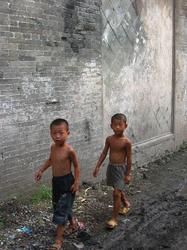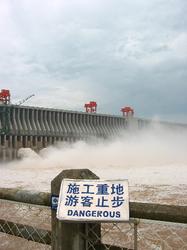Haoyi Village: ‘There were more blue skies 10 years ago’
 HAOYI, Shanxi — The electricity goes out almost every day in tiny Haoyi village. It’s the sad irony of China’s economic boom: The province that fuels much of the country’s growth and modernization often can’t afford to fuel itself.
HAOYI, Shanxi — The electricity goes out almost every day in tiny Haoyi village. It’s the sad irony of China’s economic boom: The province that fuels much of the country’s growth and modernization often can’t afford to fuel itself.
Haoyi village, with 4,000 shy and skeptical inhabitants, is an odd, isolated place surrounded by corn fields and coal mines. It is located an hour north of Linfen in southern Shanxi, a gritty, blue-collar province famous for coal, power generation, metal refining and other heavy industries. Called the “Coal Warehouse of China,” Shanxi is responsible for as much as one-third of China’s annual coal output, according to some reports.
Yet, Shanxi remains one of the poorest provinces in the country. In June, the average urban household had a monthly income of RMB 649 ($79), according to official government statistics. Rural Shanxi families earned an average of RMB 900 ($110) — total — for the first six months of 2004.
08.27.2004, 1:05 AM · Shanxi, Stories, The Trip · Comments (15)
In Xi’an, house painters hit the streets to peddle their wares
 XI’AN, Shaanxi — They arrive by the dozen, hundreds of them, every morning, pedaling eagerly to the corner of Feng Gao Xi Lu and Xi Er Huan Lu, looking something like hobo jousters, wooden poles topped with paint rollers strapped like lances to their rundown bicycles. They are ready to do battle for a day’s work. Because work for these men is never guaranteed.
XI’AN, Shaanxi — They arrive by the dozen, hundreds of them, every morning, pedaling eagerly to the corner of Feng Gao Xi Lu and Xi Er Huan Lu, looking something like hobo jousters, wooden poles topped with paint rollers strapped like lances to their rundown bicycles. They are ready to do battle for a day’s work. Because work for these men is never guaranteed.
When people need day laborers in the midwestern Chinese city of Xi’an, they don’t look in the Yellow Pages or classifieds, they head to a local street corner like this one, where workers will literally fight for the opportunity to earn RMB 50 ($6) a day.
08.24.2004, 12:38 AM · Shaanxi, Stories, The Trip · Comments (7)
Chewing the fat in Xi’an
Featuring: clay soldiers, shirtless men, secret noodles, lots of meat — and the drinking-and-driving poster boy
 XI’AN, Shaanxi — Xi’an is one of the world’s oldest cities, with ancient city walls, cherished cultural monuments and world-renowned archaeological sites. My first stop there was the five-star Sheraton Hotel. My next stop was an internet bar. Funny that while on a four-month tour of China, often the last thing I feel like doing is touring. Traveling can be tiring.
XI’AN, Shaanxi — Xi’an is one of the world’s oldest cities, with ancient city walls, cherished cultural monuments and world-renowned archaeological sites. My first stop there was the five-star Sheraton Hotel. My next stop was an internet bar. Funny that while on a four-month tour of China, often the last thing I feel like doing is touring. Traveling can be tiring.
Xi’an, a city in need of a good scrubbing, was the first destination on this trip I feel I can safely describe as seedy. The long stares I had grown accustomed to were now sideways glances. And I felt I was always one wrong move away from being ripped off. If Shanghai is a businessman in a fake designer suit, Xi’an is a used car salesman, all sly smiles, sweaty palms and false handshakes.
Of course, the same could be said of several Chinese cities that cater to a steady flow of foreign tourists, pockets bulging with cameras and cash. And, thanks to the Army of Terracotta Warriors, considered the most important archaeological discovery of the 20th century, Xi’an ranks up there with Beijing and Shanghai as a “must-see” destination in China. I had spent much of the previous two weeks hiding out in small, unassuming locales — places where the idea of having a foreign visitor is, well, completely foreign to most people — so my arrival in any “important” city like Xi’an would have felt like a slap in the face … especially after more than 20 hours of traveling.
08.17.2004, 11:58 PM · Shaanxi, The Trip · Comments (14)
The student and soldier have the initiatives
And other dam stories
 YICHANG, Hubei — I was not supposed to go to Yichang. I was supposed to go to a small village in Chongqing to stay with my student Ekin and his family. (And the first thing I was going to do was ask him where the hell Ekin came from.) But just two days before I was supposed to leave, Ekin sent the following text message to my phone:
YICHANG, Hubei — I was not supposed to go to Yichang. I was supposed to go to a small village in Chongqing to stay with my student Ekin and his family. (And the first thing I was going to do was ask him where the hell Ekin came from.) But just two days before I was supposed to leave, Ekin sent the following text message to my phone:
Dan,this is ekin. I am sorry that I can not introduce my hometown to you this time,my uncle ask me to beijing for something and i will go the day after tomorrow
So I took out my map, found Fenghuang — my location at the time — and Xi’an — which was supposed to come after Chongqing — and looked at what was in between. I settled on Yichang, which I thought appeared almost equidistant between the two — it is not, I later discovered — and is home to the Three Gorges Dam project, the largest hydroelectric dam in the world and the cause of a great deal of controversy over the past 15 years or so.
This was also an experiment of sorts. I was traveling alone, as usual, and I knew no one in Yichang. How difficult could it be?
08.12.2004, 8:48 PM · Hubei, The Trip · Comments (9)
Ancient Fenghuang: And a river runs through it
Also: The other Great Wall … and one wonderful wall of water
 FENGHUANG, Hunan — Here’s something you should never say — or think — while traveling in rural China: “Oh good. Looks like we’ll have the bus to ourselves on this ride.” Because even if the bus is empty at 7:18 a.m. and your scheduled departure time is 7:20 a.m., other passengers will come. They always come. In bunches. All at once. Out of nowhere. Carrying roosters and crying babies and buckets filled with eggs.
FENGHUANG, Hunan — Here’s something you should never say — or think — while traveling in rural China: “Oh good. Looks like we’ll have the bus to ourselves on this ride.” Because even if the bus is empty at 7:18 a.m. and your scheduled departure time is 7:20 a.m., other passengers will come. They always come. In bunches. All at once. Out of nowhere. Carrying roosters and crying babies and buckets filled with eggs.
Run out of seats? No problem. Put these plastic stools in the aisle. Run out of those? Stand right here. But please try not to step on the roosters, the crying babies or the buckets filled with eggs.
If the last-second rush doesn’t occur before your scheduled departure, it doesn’t really matter. Because the bus will wait for the rush. Could be 10 minutes, could be 20. The bus isn’t leaving until it’s well beyond full. Times printed on the tickets — if you are at the bus terminal that actually gives tickets — are only guidelines, suggestions, the way things would happen in a perfect world.
And this, my friends, is not a perfect world. This is western Hunan Province in southern China. This is the trip from Jishou to Fenghuang. And soon the teenage girl sitting in the seat in front of you will be puking out the window. And you’ll be breathing through your mouth, hoping that none of the vomit flying out of the bus finds a way to fly back in.
08.10.2004, 6:07 PM · Hunan, The Trip · Comments (6)
I am a Chinese tourist (and I love Mao)
 SHAOSHAN, Hunan — To most outsiders, one contradiction in Chinese society stands high above the rest: The people’s adoration of Chairman Mao. Ask a Westerner about Mao Zedong and you’ll hear about more than 20 million dead and the dismal failure of the Great Leap Forward. You’ll hear about millions more dead and the draconian Big Brother policies of the Cultural Revolution. Ask a Chinese about Mao and you’ll hear about a great leader. You’ll hear about the founding father of modern China.
SHAOSHAN, Hunan — To most outsiders, one contradiction in Chinese society stands high above the rest: The people’s adoration of Chairman Mao. Ask a Westerner about Mao Zedong and you’ll hear about more than 20 million dead and the dismal failure of the Great Leap Forward. You’ll hear about millions more dead and the draconian Big Brother policies of the Cultural Revolution. Ask a Chinese about Mao and you’ll hear about a great leader. You’ll hear about the founding father of modern China.
The official word around China is that Mao was 70 percent right and 30 percent wrong. We can — and should — quibble about that ratio. But, whatever the wrong portion is, the youth of China seem to know or care little about its details. And many who lived through the wrongs have somehow forgotten, been “re-educated” or just keep their thoughts to themselves. Sometimes you’ll hear indirect references — like my Chinese instructor lamenting the fact that the government forced her to stop studying English back in the 1960s — but never does anyone come right out and blame Mao. That would be blasphemous.
Mao has assumed a sainthood of sorts. To speak ill of him is unimaginable. It is sacrilege.
A trip to Shaoshan, Mao’s hometown in Hunan, has become a pilgrimage for many Chinese. In the 1960s such trips were “encouraged,” and the government had a paved road and railway line built to connect the small village with Changsha, Hunan’s capital. Now, folks flock to the site voluntarily. Got to pay your respects to the supremely beloved Chairman Mao.
I decided the best way to visit Shaoshan would be the way most Chinese visit Shaoshan (or any other tourist attraction, for that matter) … I joined a Chinese tour group.
08.05.2004, 10:21 PM · Hunan, The Trip · Comments (11)
